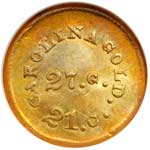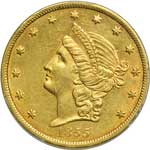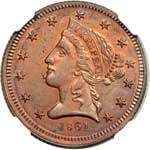
|
Sale 72
February 2-5. 2013
| Lot |
Photo |
Description |
Realized |
Lot 1931 |
 |
August Bechtler, 1 DOLLAR CAROLINA, 27 Gr. 21 Carats. ANACS graded EF-45. Lovely golden toning, a well struck example. The Bechtler mint was a private enterprise conducted at the residence of Christopher Bechtler, and operated by him and the Bechtler family. The enterprise was highly esteemed in its time, well covered in newspapers and financial journals, and served great utility in providing circulating coins in that region. There were no mints in North Carolina or Georgia until 1838, and the Bechtler enterprise, which began in 1830, filled an important niche. The federal government did not pester the Bechtlers, but allowed the private mint to continue in full operation, although now and again mention of it was made in the Annual Report of the Director of the Mint (PCGS # 10040) .
Estimated Value $1,400 - 1,500.
View details and enlarged photos
Check results on similar lots
| Realized
$4,600 |
Lot 1932 |
 |
1851 U.S. Assay Office $50 "Slug", 880 THOUS. Reeded Edge. NGC graded EF-45. Untoned with nice details, clear date, some minor weakness on some of the outer legend at top. A few light marks under the eagle's left wing.
While the government�s response to the need for an adequate coinage was slow and never satisfactory during the California Gold Rush of the late-1840s and early 1850s, two institutions were established (the State Assay Office of California and the United States Assay Office) that did provide an unconventional and partly successful attempt to supply a frontier area with an acceptable quantity of an "official" circulating medium.
The private coinage proscription was not enforced by the public or government because the State Assay Office failed to mint enough ingots for the local demand. Ironically, an institution that was designed to replace the need for private gold minting actually preserved it (i.e., Moffat & Co.'s undebased coins from the first period continued in circulation) and in fact stimulated its resurgence (i.e., the second period of private gold coinage).
The lettering is historic Assay Office 1851 $50 Gold Slug includes in its inscription around the border UNITED STATES ASSAY OFFICE OF GOLD SAN FRANCISCO CALIFORNIA. This is the 880 THOUS variety, made of necessity as considerable additional refining effort would have been needed to have brought the alloy up to the federal standard of 900 (which was accomplished, but later). The reverse is of the so-called engine-turned design, popularly attributed to Augustus Humbert who once made watch cases, presumably with engine turning as well.
The $50 octagonal "slug," called an adobe in local trade, as perhaps these pieces resembled bricks in a way, was a mainstay of California commerce in the wild and woolly days. Such pieces were used in large transactions, being the coin of choice, as paper money was illegal in the state (under the Constitution of 1850), and lesser denomination gold coins were not plentiful. With little in the way of literary license one can imagine that this piece did its duty in saloons, bordellos, and gambling halls.
Such octagonal $50 pieces were last minted in 1851 & 1852, but were continued in use for much of the rest of the decade. Many were sent to the Philadelphia Mint, where they were melted into bullion, then recoined into federal denominations. The S.S. Central America, lost at sea in 1857, carried a small supply of such pieces, apparently destined for Philadelphia. It is likely that by 1860 most slugs disappeared, as by this time the San Francisco Mint had been in operation since 1854, and regular issue double eagles were plentiful in commerce (PCGS # 10211) .
Estimated Value $20,000 - 22,000.
View details and enlarged photos
Check results on similar lots
| Realized
$31,050 |
Lot 1933 |
 |
1855 Kellogg & Co. (San Francisco) $20 Gold PCGS graded Genuine AU Details. Cleaning. Still a very nice looking coin. Very close to Mint State.
With the imminent opening of the San Francisco Mint, the United States Assay Office ceased operations on December 14, 1853. At that time no private firms were coining gold. The United States Assay Office, under contract to Messrs. Curtis and Perry, was being reconverted to house the authorized United States Branch Mint.
The only coins that were still circulated were Assay Office $50, $20, and $10 coins, along with the Moffat & Co. issues; the other private issues had been discredited and melted long before for recoinage into official "ingots." The closing of the Assay Office, the lack of private firms issuing coins, the shortage of coins surviving the Second Series issues, and the exportation of what coins there were led to a disastrous financial situation in California before the branch mint opened. High-grade gold bullion continued to flow into the area with no place for it to be coined into money, while the United States customs offices hoarded all the coins which they received. It was under these circumstances that John G. Kellogg and G. F. Richter, cashier and assayer of Curtis, Perry and Ward, were implored by California bankers to open their own assaying office on December 19, 1853. When Curtis, Perry and Ward ceased operations, Kellogg, along with another of the employees, Assayer G. F. Richter, opened his own office on December 14, 1853. Curtis, Perry and Humbert all endorsed Kellogg's operation and integrity. Kellogg operated a gold melting and assaying office in the basement of J. P. Haven's building, No. 106 Montgomery Street.
Twenty-dollar gold pieces (and later a $50 denomination) were rushed into production in 1854 and 1855 to ease the shortage.
A fascinating and historic privately minted gold coin featuring designs adapted from the Federal $20 coinage, this still lustrous example has choice surfaces despite the light cleaning, and a bold strike on all but the stars. Everything you would want from the grade, and probably then some (PCGS # 10225) .
Estimated Value $4,000 - 4,500.
View details and enlarged photos
Check results on similar lots
| Realized
$7,188 |
Lot 1934 |
 |
1861 Copper $5 Clark-Gruber K-10c. NGC graded MS-64 BN PQ. Some mint red visible on the obverse. Pop 1; none finer at NGC
Although not the only enterprise destined eventually to alleviate the problems of trading Colorado gold dust by converting it into coin, Clark, Gruber & Co. became the most respected financial organization in Colorado's pioneer days. It acted both as a bank and a mint, eventually with branch offices in Central City, Colorado, and Salt Lake City, Utah, and maintained a high reputation for competence and integrity.
During its operation, Clark, Gruber & Co. issued a total of $594,305 worth of gold coins and a few rare copper strikes from the same dies. The gold was widely accepted at par, and the firm's reputation was above reproach. Historian Jerome Smiley felt that Clark, Gruber & Co.'s operations "were of immense benefit to the general banking business of the firm and gave it many advantages over competitors without a minting annex. An enormous and profitable business was transacted, and in all its operations the firm's honor and integrity were never questioned."
Estimated Value $1,000 - 1,250.
View details and enlarged photos
| Realized
$7,188 |
|
|